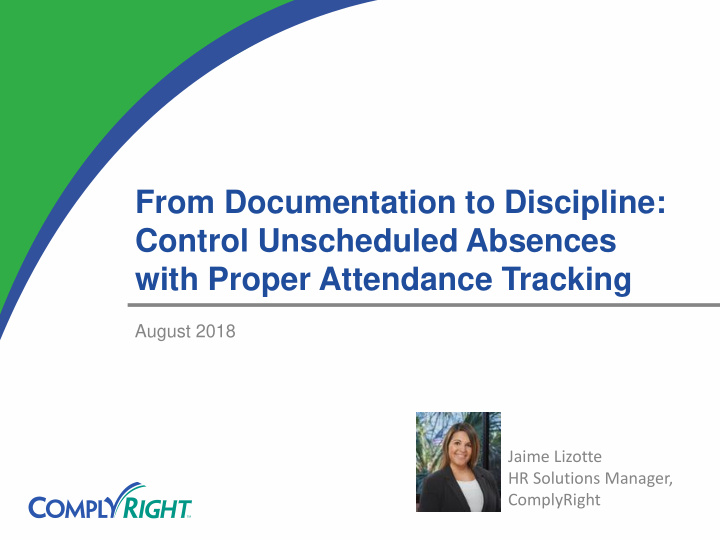



From Documentation to Discipline: Control Unscheduled Absences with Proper Attendance Tracking August 2018 Jaime Lizotte HR Solutions Manager, ComplyRight
Welcome! Use the chat box on the left to ask questions Audio for today's webinar will come through your computer speakers. Please be sure your speakers are turned on and you have the volume turned up If you are signed on more than once, please locate the duplicate log-in and close it. This will create a better audio experience All attendees will receive a link to the presentation and slides in a follow up email
What We’ll Cover The cost of excessive, unscheduled absenteeism Why companies should track attendance The do’s and don’ts of attendance tracking Employee leave laws that impact attendance Compliance pitfalls with incomplete recordkeeping Demo of a cost-effective solution for easy tracking
The Cost of Unscheduled Absenteeism
Did You Know? Nearly 15% of companies report using no method to track employee attendance. 2017 HRdirect survey The Impact of Absenteeism on Small Businesses in the U.S.
Defining Absenteeism Two types: Planned and unplanned Planned absences consist of vacation or personal time/PTO Unplanned absences can include arriving to work late, leaving early, taking long lunches, calling in sick or simply not showing up at all
Did You Know? According to Absenteeism: The Bottom-Line Killer by Circadian: Unscheduled absenteeism costs roughly $3,600 per year for each hourly worker and $2,650 each year for salaried employees.
Additional Consequences Lower morale due to increased workloads Frustrated managers and supervisors Loss of productivity and missed deadlines Reduction of services Negative word-of-mouth by unhappy customers Decreased product quality Increased risk for on-the-job injury due to fatigue Employee turnover
Legally Protected Employee Leave
Family and Medical Leave Act The FMLA applies to private employers with 50 or more employees, and to public agencies of all sizes. FMLA requires covered employers to provide eligible employees with up to 12 weeks of unpaid leave for: A birth, adoption or placement of a foster child To care for a close family member with a serious health condition To care for or an employee’s own serious health condition To care for a covered family service member/veteran with a serious injury or illness
Americans with Disabilities Act The ADA applies to companies with at least 15 employees It requires employers to consider making accommodations for individuals with a disability A disability could mean anything from a sleep disorder or depression to a chronic disease In some cases, an extended leave of absence may be required
Pregnancy Discrimination Act The PDA applies to employers with 15 or more employees Prohibits discrimination against pregnant applicants and employees Requires you to apply the same rules and benefits for pregnancy-related absences as available for other medical absences
USERRA Uniformed Services Employment and Reemployment Rights Act requires both private and public employers to provide employees with leave to serve in the military. USERRA also requires: Employers to reinstate employees returning from military leave Grant seniority and applicable benefits to returning members Train or otherwise qualify employees returning from military duty
Title VII of the Civil Rights Act Under Title VII, employers have a duty to accommodate the religious activities of employees. This may include allowing time off for certain holidays or religious practices Employers are not required to make religious accommodations if they pose an undue hardship on the business
State and Local Laws Many states, cities and local governments have laws that differ from federal law. They may, for example: Apply to smaller employers Have less stringent requirements Provide longer leave periods Expand the definition of serious health condition Apply to individuals other than immediate family Require paid leave instead of unpaid leave Provide leave for certain activities, such school events
Other Protected Absences Birth, adoption or becoming a foster parent Medical or health-related issues Caring for a sick relative, partner or service member Workers ’ compensation injury or proceedings Donating blood, an organ or bone marrow Religious holiday or practice Military service obligation Jury duty or witness responsibilities Voting in an election Certain volunteer work (e.g., firefighter or disaster recovery) Attending a child’s school activities
The DO’s (and DON’Ts) of Attendance Tracking
Attendance Tracking DO’s DO have a written policy: A well-developed attendance policy should set clear expectations for employees and get them on the same page with management. DO spell out the consequences: Your attendance policy should inform employees when chronic lateness and absenteeism are cause for discipline. DO get employee acknowledgment: Have your employees acknowledge receipt of the policy. DO record and code every absence and tardy: This will allow you to identify troubling patterns and keep track of legally protected leave.
Attendance Tracking DON’Ts DON’T be inconsistent: Treat similar employees in a similar fashion. DON’T ignore problems: Document and address them in a timely manner. DON’T skimp on the details: Your written warnings should be specific and include essential information. DON’T overlook employee acknowledgment: Your employee should sign and date the warning. If they refuse, have a witness sign instead.
Control Unscheduled Absenteeism with the right tool Attendance Calendar Smart App
Attendance Calendar Smart App Recap $60 per year – unlimited employees No downloads or installs – web-based Over 25 absence codes to use or create your own absence codes Allows for manager/supervisor permissions Print with one-click Experienced customer success specialists Seamless integration with other apps across platform
HR Solutions For more information visit: www.hrdirectapps.com
Questions Reminder: All attendees will receive a link to the presentation and slides in a follow up email.
Recommend
More recommend